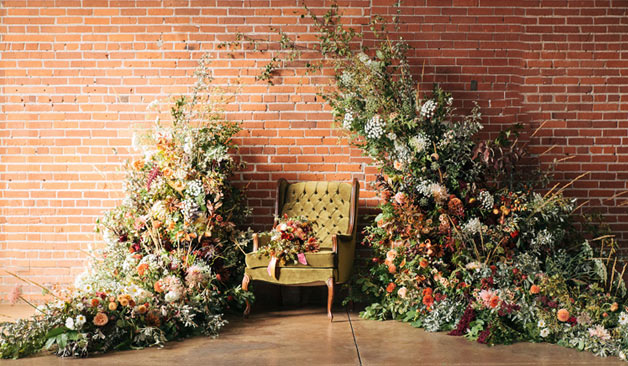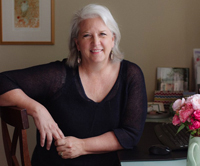- 3 Easy, Reliable, Productive Cut Flowers: Sunflowers, Zinnias & Rudbeckia
- 5 Factors That Determine Vase Life of Cut Flowers
- 2019 American Flowers Week: Combining the Art of Floral Design & Couture
- Celebrate the 7th American Flowers Week | Johnny's 2021 Botanical Couture
- Celebrating the 8th American Flowers Week | Johnny's 2022 Botanical Couture
- Collective Selling Models for Flower Farmers: Flower Hubs That Work
- 5 Cool Flowers to Plant Now | Lisa Mason Ziegler's Secrets for Growing Hardy, Cool-Season Annuals
- Cut-Flower Harvesting & Post-Harvest Care | Best Practices from Pros in the Slow Flower Community
- Cut-Flower Kit | Guide for Market Growers (PDF)
- Easy Cut-Flower Garden Map | For Growers New to Flowers (PDF)
- Easy Cut-Flower Garden Planner | For Growers New to Flowers (PDF)
- From Color to Climate: 5 Floricultural Trends Subtle & Seismic
- Flower Culture by Crop | Comparison Chart | Days to Germination, Weeks to Transplant, Days to Harvest (PDF)
- Flower Farmers' Favorite Fillers & Foliage | Recommendations from 3 Farmer-Florists
- Getting Started in Cut-Flowers | Top 15 Cuts
- Heat & Drought: How Flower Farmers Are Adapting to Changing & Challenging Climatic Conditions
- Introduction to Overwintering Flowers | Guide to Overwintering Flowers
- An Introduction to Producer Marketing Cooperatives | M Lund & Associates
- How Day Length Affects Cut-Flower Production
- Growing Flowers in Hoophouses & High Tunnels: Cool-Weather & Hot-Weather Options
- Starting a U-Pick Flower Farm, From A-to-Z
- Growing Flower Seedlings for Profit
- Roadside Flower Stand Basics: Success Tips for On-Farm Retail
- Year-Round Flower Production Strategy
- Overwinter Flower Trials | Multiyear Results for 30+ Crops | Johnny's Selected Seeds | XLSX
- Seeding Date Calculator | Johnny's Recommended Flowers for Overwintering | XLSX
- Pricing & Profitability for Flower-Farmers | Pointers from a Diversity of Pros
- Sustainable Farming Methods | A Survey of Flower Farmers' Best Practices
- Just Add Flowers | An Introduction to Companion Planting for Vegetable & Herb Gardeners
- Slow Flowers Palette & Petal Crushes | Evolving Colors & Shape-Shifts in Floral Industry Trends
- Johnny's and Slow Flowers | Johnny's Selected Seeds
- Slow Flowers | Celebrating Fifth-Season Regional Design Elements
- Slow Flowers Floral Forecast | A Summary of Industry Insights & Trends
- Building a Better Market Bouquet: Tips, Techniques & Recipes for Flower Farmers
- Slow Flowers | Tips for Staging On-Farm Floral Workshops | Johnny's Selected Seeds
- Wedding Wisdom 101 | 10 Beginner Tips for Entering the Wedding Floral Landscape
- Succession-Planting Flowers | Scheduling & Planning, Sowing Frequency, Recordkeeping & Recommendations
- Succession-Planting Interval Chart for Flowers
- Sustainable Floral Design | Techniques & Mechanics for Foam-Free Floristry | Tobey Nelson & Debra Prinzing
- Video: Mason Jar Bouquet Tutorial
- Video: How to Build a Bouquet
- Video: Tobey Nelson | Sustainable Floral Design | Slow Flowers Summit
- Video: Economic Considerations in Overwintering Cut Flowers | Johnny's Selected Seeds
- Top 10 Cut-Flower Varieties for Direct Seeding
- Video: Floating Row Cover | Baby "Cool Flower" Protection from Whipping Winter Winds
- Video: The Procona System for All-in-one Flower Harvest, Transport & Display
- Johnny's Overwinter Flowers Tunnel: Trellising, Supports, Ground Cover & Spacing
- Video: Irrigation Considerations for the Overwinter Flowers Tunnel | Johnny's Selected Seeds
- Video: Johnny's Overwinter Flowers Trial Recap
- Video: Producer Cooperatives for Small-Scale Farmers | Johnny's Webinar Series
- Climate Adaptation for Vegetable & Flower Farmers | Johnny's Educational Webinar Resources
- Chrysal CVBN Flower Conditioner | SDS
- Webinar Slide Deck | New-for-2023 Flowers & Floral Supplies | PDF
- Chrysal Clear Bulb Flower Conditioner | SDS
- Chrysal Professional 2 Transport & Display T-Bag | SDS
- Chrysal Classic Professional 2 Transport & Display (Holding) Solution | SDS
- Chrysal Clear Universal Flower Conditioner | SDS
- Webinar Slide Deck | Flower Growing in Southern States | PDF
- Choosing Flower Crops to Overwinter | Guide to Overwintering Flowers
- Edible Flowers List: Top 20 Favorites from the Slow Flowers Community
- Floral Standards for Flower Farm Collectives and Cooperatives
- Bloom to Boom: Flower Farm Profitability
- Choosing Tulip Varieties for Forcing | Guide to Forcing Flower Bulbs
- Forcing Tulip Bulbs | Guide to Forcing Flower Bulbs
- Snapdragon Groups Explained
- Flowering in the South: Profiles of 5 flower farmers who cope with temperature, humidity, pest & weed pressure
- Video: Flower Growing in Southern States | Johnny's Webinar Series
- 10 Tips for Building a Profitable Cut-Flower Business
- Introduction to Forcing Flower Bulbs in Soil | Guide to Forcing Flower Bulbs
- U-Pick Power for Your Flower Farm | Johnny's Webinar Series
- Eat Your Flowers: Serve Up That Wow Factor With Edible Flowers
- U-Pick Power for Your Flower Farm | Johnny's Webinar Series
- Flower Growing in Southern States | Johnny's Educational Webinar Series
- Chrysal Clear Bulb T-Bag | Cut-Flower Conditioner | SDS
- Chrysal Professional 1 Hydration Solution | SDS
- Chrysal Professional 3 Vase Solution Powder | SDS
- When to Start Seeds for Overwintered Flowers | Guide to Overwintering Flowers
- Webinar Slide Deck | U-Pick Power for Your Flower Farm | PDF
Better-Choice Mechanics & Techniques for Foam-Free Floristry
(Click through to get the full picture!)
Green floral design is gaining wider adoption as influential florists engineer better solutions, shape alternative design techniques, and add their voices to the #foamfree and #sustainablefloristry conversation.
"Eco and nontoxic" floral design was the very first topic I covered in the very first Slow Flowers Floral Insights and Industry Forecast, published in 2015. I noted that many Slow Flowers designers and farmer-florists were actively rejecting floral foam while seeking new methods, techniques, and mechanics for arranging flower stems. Three years later we returned to the theme, highlighting new "chemical-free" mechanics for floral design in the 2018 Forecast.
The movement continues to spread apace. As more and more florists hearken back to the days of foam-free mechanics predating the 20th Century, they are taking chicken wire, moss, and branches to brand new heights, while at the same time rolling out their own new materials, methods, and products.
Why does sustainability in floristry matter?
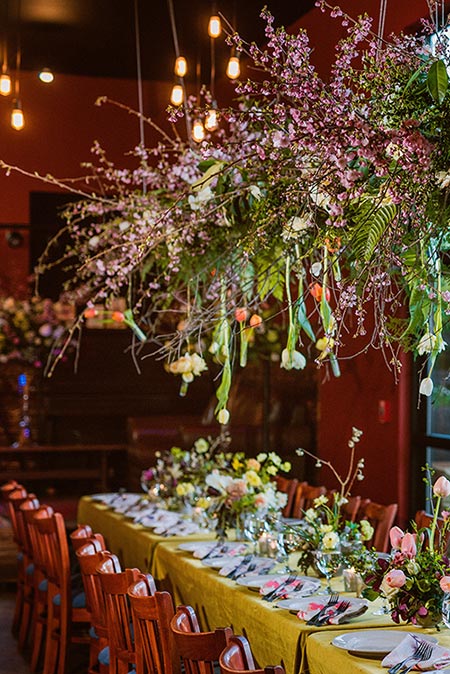
Because we can: we have the technology as well as better options. Much of the recent initiative is focused on finding a replacement for floral foam, a product used for decades by florists, retailers, wire services, and wedding/event companies. Concern about this ubiquitous "tool" of conventional and mainstream floristry has been growing over the past decade. In its most common form it resembles a green, spongy, foam-shaped brick. Soaked in water before it's placed in a vessel or attached to a structure, the brick holds water for a period of time; thus, it is believed to hydrate cut flower stems while also holding them in place in everything from a centerpiece to a casket spray.
Production of this product shows little to no sign of slowing down. There are numerous companies manufacturing and distributing variations on this product to professional florists and flower shops worldwide. Formulations are proprietary, and it can be difficult to locate and decipher Safety Data Sheets for the products in use today. Patents for earlier floral foam products, however, reveal phenol-formaldehyde or urea-formaldehyde as key ingredients in their manufacture. One company's disclosure from 2009 contains this description: "Green fine-celled thermoset phenolic plastic foam. May be irritating to eyes, skin, and respiratory tract. May contain formaldehyde and/or carbon black. Prolonged exposure may cause cancer."
Concern about exposure to the humans who handle and breathe the dust from these products as well as as its disposal in landfills has escalated. After reviewing one company's website, experts at Seattle Public Utilities advised: "Foam products are not compostable, are not recyclable, and once the material is in the garbage and headed to the landfill, there is no intrinsic value of any sort to a degrading characteristic."
A number of influential floral designers are now speaking up about green and sustainable alternatives to floral foam, recommending new design methods that do not employ its use. You can track some of these voices and the techniques they are promoting on social media. Check out hashtags like #foamfree, #nofloralfoam and #sustainablefloristry to find the influencers and see their work — it's enlightening.
Greener Options
One influencer is Tobey Nelson, founder of the Whidbey Flower Workshop and owner of Tobey Nelson Events + Design, based in Langley, Washington. A longtime Slow Flowers member, she is actively shedding light on the environmental and health concerns of floral foam. With others, Tobey is embracing greener tools and techniques as this topic moves from the fringe to the mainstream. She teaches large-scale event design techniques to florists, farmers, and farmer-florists at her own workshops, as well as at the Slow Flowers Summit in St. Paul, Minnesota, and at the Sustainable Flower Workshop in Calgary, Alberta, held in 2019.
According to Tobey, large-scale installations require different design and construction skills than centerpieces or bouquets. Arches, arbors, chuppahs, hanging floral chandeliers, vertical florals that frame a doorway or climb a wall, and freestanding sculptural pieces all have in the past relied on a hidden foam "base."
Green mechanics are part of "sustainable floristry," she says. "Sometimes florists have to be engineers and 'MacGyver' their designs. I love to make big, crazy stuff without foam and play around with all the engineering that's required — using everything from floral mechanics to structural components and rigging methodology."
Watch the video of Tobey's Slow Flowers Summit presentation to learn more about these techniques…
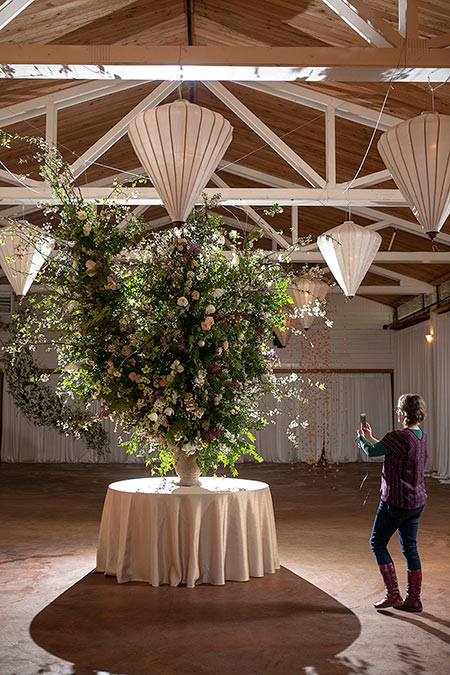
I recently caught up with Tobey to talk further about her approach to foam-free mechanics.
Q: How do you define "sustainable floristry"?
A. "Foam-free" is only one piece of the larger practice of sustainable or eco-floristry. We can think of ecofloristry as a 3-pronged movement: first, rethinking the mechanics we use; second, reducing our waste stream, and third, how we source and distribute locally-grown flowers.
Wholistically, however, ecofloristry is part and parcel of sustainable agriculture. Think of water conservation, soil health, and the way you're feeding your flowers, interacting with the birds and the bees, and so forth. Equally fundamental to the concept of "sustainability" is how you treat employees and customers, as well as ensuring that you make a sustainable living for yourself and your business, be it a farm, floral studio, or retail flower shop.
Q: What are the common forms of floral foam?
A. Due to proprietary formulas, manufacturers are not forthcoming with information; they want to protect their recipes. We do know that formulations are petrochemical-derived and include formaldehydes, among other ingredients. In all its forms, floral foam is a single-use plastic. It creates a dust that we breathe in. It is not compostable and there is no good information on safely disposing of it. Ultimately, it becomes a microplastic, which is one of the most problematic forms of plastic waste in our environment.
Q. Why have florists traditionally used floral foam?
A. It's a convenience product designed to provide stability and hydration. I don't think it is a great water source solution for stems, and there are other mechanics available to hold stems in place. For an overhead installation, I have seen stems inserted in foam that later fall out as the product dries or the flower stems shrink.
I don't want to belittle anyone for the choices they make, but I encourage designers to think through their choices. I always ask: "How am I going to design this without foam?"
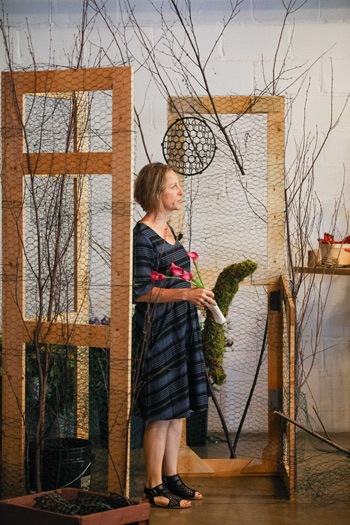
Q. How are things changing?
A. As residents of this planet, we have realized that we need to come to grips with our plastic problem. Largely, efforts are geared toward alternative packaging for food, cosmetic goods, and medical products — but many recognize those are just three of the tributaries contributing to a river of plastics now filling the seas. Just as there are people denouncing plastic bags, there are people denouncing floral foam.
Q. What is the first and easiest way to get started with a sustainable design approach?
A. You could roll up some chicken wire in a loose ball, insert it into a vase and start playing around with your own flowers. If you've booked a wedding with personal flowers plus 10 centerpieces, it's a perfect time to try the chicken wire option over foam. If it's not possible to salvage or recycle the chicken wire after your event, use something compostable — try creating a tangle of twigs, or using a handful of curly willow (Salix matsudana) or wood wool (aka “excelsior,” shredded wood fiber in a range of thicknesses).
Q. What are some other useful foam-free mechanics?
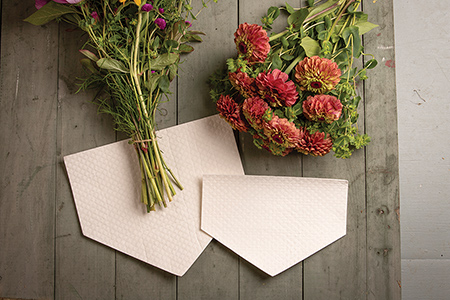
Simply wet the wrap, swaddle the end of your bouquet tightly, and cover with an impermeable bag or film and rubber band for transport.
100% plant-based wraps are reusable, compostable, and biodegradable.
A. I use the following mechanics and teach the specifics of their use in my workshops:
- Hidden water sources
- Chicken wire
- Eco-Fresh Bouquet Eco-Wraps, a floral sponge-wrap system designed by former florist Debbie DeMarse. The recyclable and compostable product is moistened and wrapped around the cut stems of a bunch or a bouquet of flowers, to keep them hydrated.
- Holly Chapple x Syndicate Sales pillows and eggs (USA-made). The shapes mimic more rustic chicken wire forms and can be reused/recycled.
- Moss-filled "roulade," a crescent-shaped form made of chicken wire-bound moss centers. When soaked in water, it will hold and hydrate flower stems and can be mounted on an arbor or structure.
- "Stakes-in-concrete," a vertical structure comprised of branches secured in a bucket filled with Quickrete. All sorts of foam-free mechanics can be attached to the piece for positioning flowers, foliage, and other botanicals.
- Freestanding wooden frame with chicken wire forms.
- Reuseable floral tubes/water picks.
- Learn more about foam-free mechanics and see photos on Tobey's website. Visit tobeynelson.com and find out when classes, videos, and webinars are happening, as well!
- Learn more about packaging sustainability from Debra Prinzing's Slow Flower Journal in Florists' Review: Beyond Plastic.
- Join the American-grown flowers movement — become a member of the Slow Flowers Society and sign up for the Slow Flowers Podcast.
- Sign up for the Flower Podcast with Scott Shepherd, aka Cutflower Scott, for engaging and educational episodes on leading-edge topics in floristry. Listen to Scott's interview of guest Susan McLeary, Floral Artist & Educator, and author of the List of Reliables, noted above by Tobey. You can sign up for a course with Susan, aka PassionFlower Sue, at her website, susanmcleary.com.


